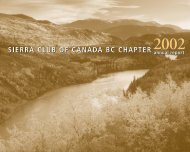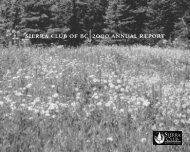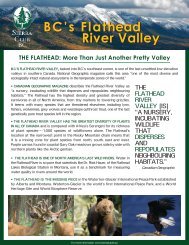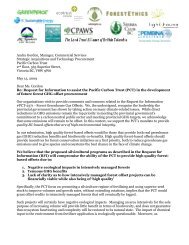Bogus Business? Bottling Bute - Sierra Club BC
Bogus Business? Bottling Bute - Sierra Club BC
Bogus Business? Bottling Bute - Sierra Club BC
Create successful ePaper yourself
Turn your PDF publications into a flip-book with our unique Google optimized e-Paper software.
WATER<br />
<strong>Bogus</strong> <strong>Business</strong><br />
<strong>Bottling</strong> <strong>Bute</strong><br />
Disclosure and Sources<br />
The bottled water business is like the bottles it sells – watertight. A<br />
culture of non-disclosure permeates the industry, right down to individual<br />
bottlers. In this blackout, even current federal reports<br />
on Canada’s bottled water industry date back to 2006, based<br />
on estimates and assumptions, not compiled from hard data.<br />
The <strong>BC</strong> Government, which sells water licences,<br />
stopped updating the information available online in<br />
May 2010. Applications for Crown land are online<br />
only until a decision has been made, then poof!<br />
Gone!<br />
Water and land applications are handled by<br />
the new Ministry of Natural Resource Operations<br />
(MNRO) (WS Jan-Feb 2011). MNRO<br />
was rolled out in late 2010 by departing<br />
Premier Gordon Campbell to facilitate<br />
the liquidation of publicly owned natural<br />
resources. Transparency and public<br />
engagement can impede the free<br />
flow of public assets to private interests<br />
– the absence of both is likely<br />
to be the MO at MNRO.<br />
Watershed Sentinel asked<br />
questions of many people<br />
while researching this article.<br />
Government was better<br />
at answering than<br />
the industry: of all<br />
the phone calls and<br />
emails sent out to<br />
bottlers and licencees,<br />
only<br />
two would<br />
answer any<br />
questions.<br />
by Arthur Caldicott<br />
The bottled water industry enjoyed<br />
impressive growth until 2007,<br />
the result of relentless advertising,<br />
ubiquitous availability, and a propaganda<br />
assault on public water systems.<br />
2.36 billion litres of water were<br />
sold in Canada in 2006, worth an<br />
estimated $708 million. In the US in<br />
2007, 33.3 billion litres were sold for<br />
$11.5 billion.<br />
In 2008, growth turned negative.<br />
Recession squeezed shoppers’ wallets,<br />
and bottled water fell off their<br />
shopping lists. It wasn’t just recession,<br />
though. People weren’t buying<br />
the lie about unsafe tap water. And<br />
mountains of bottles in blue boxes<br />
and landfills were evidence that there<br />
were more consequences to bottled<br />
water than just water.<br />
“Tap water” campaigns started<br />
to show some real successes, led in<br />
Canada by the Council of Canadians,<br />
and given a boost in 2009 by the Federation<br />
of Canadian Municipalities<br />
(FCM). FCM urged municipalities to<br />
phase out the sale and purchase of bottled<br />
water, and to develop awareness<br />
campaigns about the positive benefits<br />
and quality of municipal water supplies.<br />
It has found real traction in municipal<br />
governments.<br />
The bottled water industry had<br />
reached a turning point. At the pricesensitive<br />
low-end, and in the sillier<br />
by the year “premium water” market,<br />
excess bottling capacity meant the<br />
boom was over. “Mom-and-pop” water<br />
shops were closing their doors.<br />
Canada’s three top bottlers are<br />
Coca-Cola (Dasani, tap water from<br />
various cities in Canada), Pepsi-Cola<br />
(Aquafina, tap water) and Nestlé<br />
(Pure Life, in <strong>BC</strong> the source is spring<br />
water from Hope). Canada’s largest<br />
private bottler, Ontario-based Ice River<br />
Springs, had by 2010 closed its <strong>BC</strong><br />
operations, including its bottling plant<br />
at Illecillewaet Springs in Glacier National<br />
Park – the third largest bottled<br />
water licence in <strong>BC</strong> – and another<br />
Watershed Sentinel<br />
24<br />
March-April 2011
WATER<br />
plant in Cranbrook which obtained<br />
water from a local well. Ice River<br />
Springs now serves its <strong>BC</strong> market<br />
from Calgary. In a smaller but similar<br />
rationalization, Snowcap Waters of<br />
Fanny Bay sold its mid-Vancouver Island<br />
customer base to Duncan-based<br />
Columbia Ice, and closed its bottling<br />
plant forever.<br />
Some bottlers obtain water from<br />
“pristine glacial” sources and from<br />
a local well or tap. Natural Glacial<br />
Waters trucks its Névé brand “super<br />
premium glacial water” 160 km from<br />
the Adam River west of Sayward to<br />
its plant at Fanny Bay on Vancouver<br />
Island. Its less special “glacial spring”<br />
brand, Canadian Icefield, is obtained<br />
from a local well with no glacier anywhere<br />
nearby. Perhaps the glacier is<br />
When we’re done, tap water<br />
will be relegated to showers<br />
and washing dishes.<br />
—Susan Wellington, president of<br />
Quaker Oats’ US beverage division.<br />
underground, suggesting that hell is<br />
freezing over. Its primary markets<br />
are Asian. Watermark Beverages of<br />
Vancouver follows the same scheme.<br />
It obtains its Ice Age and Canadian<br />
Music water from Alpine Creek in<br />
Toba Inlet, and the rest from Vancouver’s<br />
municipal supply. Its big market<br />
is California. These and many other<br />
bottlers will bottle their water with<br />
your label, or you can supply your<br />
own water.<br />
A drop in the bucket<br />
Until 2000, there were about 29<br />
licences issued in <strong>BC</strong> allowing water<br />
removal from streams, lakes, and<br />
springs for bottling purposes. From<br />
2000 to 2007 – the end of the boom<br />
years – there were another 13 issued.<br />
Issued licences total 22,637 cubic metres<br />
per day (m3/d) (22,637,000 litres).<br />
When it is multiplied out to litres<br />
or gallons, it seems like a lot of water.<br />
Compared to the volumes of water removed<br />
from <strong>BC</strong>’s lakes and streams<br />
for most other purposes, however,<br />
water for bottling is simply not on<br />
the same scale. It is even less than the<br />
36,000 m 3 /d used for snow-making at<br />
Whistler-Blackcomb, less than a tenth<br />
Continued on Page 26 <br />
Watershed Sentinel 25<br />
March-April 2011
<strong>Bute</strong> continued<br />
the water permit for the Harmac pulp<br />
mill in Nanaimo. And it’s a drop in the<br />
bucket compared to the water used for<br />
power generation.<br />
The application fee for a bottling<br />
licence is $500 for less than 200 cubic<br />
metres per day, and $2000 for 200<br />
m3/d and up. The annual water rental<br />
is 85 cents per thousand cubic metres.<br />
Actual annual revenue to government<br />
in 2010 was a puny $8845. [This total<br />
is impossible to reconcile with the<br />
quantity of water licenced. Government<br />
was unable to explain it, either.]<br />
<strong>Bottling</strong> and Bulk Exports<br />
The licence requires that water be<br />
sold in containers of 20 litres or less.<br />
Once it’s in a bottle, it can be sold<br />
anywhere. There is no limit to how<br />
much bottled water can be exported.<br />
<strong>Bottling</strong> is quite a different scale<br />
of water handling than large-scale<br />
exports in which pipelines or tankers<br />
move the water, which once at the destination<br />
can be pumped directly into<br />
municipal water systems. <strong>BC</strong>’s Water<br />
Protection Act prohibits the direct<br />
removal of water from <strong>BC</strong>, and prohibits<br />
the large-scale transfer of water<br />
between major watersheds.<br />
At the national level, most of<br />
Canada’s water is largely unprotected,<br />
and vulnerable to the large diversion<br />
schemes which crop up from timeto-time.<br />
The International Boundary<br />
Water Treaty Act prohibits large-scale<br />
exports along Canada’s borders. Water<br />
is NOT exempted in the North American<br />
Free Trade Agreement (NAFTA),<br />
as are raw logs for example. The definitive<br />
answer to the NAFTA question<br />
will only be decided when some<br />
party forces a legal decision. David<br />
Boyd in Unnatural Law says that the<br />
free trade agreement places Canada’s<br />
water at risk.<br />
<strong>Bottling</strong> <strong>Bute</strong> and Other Inlets<br />
As the bottled water business<br />
retrenched in 2008, something unexpected<br />
happened. At least 51 licence<br />
applications were submitted for water<br />
for bottling from streams in Knight,<br />
<strong>Bute</strong>, Toba and Jervis Inlets. While<br />
some have since been abandoned, between<br />
34 and 40 or more applications<br />
are still active. Each application is for<br />
112.5 m 3 /d.<br />
The project plan is described<br />
in a report by Sigma Engineering.<br />
The intent is to extract the permitted<br />
quantity of water from each stream in<br />
each of the inlets on a daily basis. A<br />
skiff will approach the mouth of each<br />
stream, and with a flexible hose and<br />
a pump where necessary, will transfer<br />
Watershed Sentinel 26<br />
March-April 2011
WATER<br />
the water to a tank on the skiff. The<br />
capacity of the tank on the skiff is<br />
112.5 m3/d – apparently the tank determined<br />
the quantity of water applied<br />
for from each stream.<br />
The skiff will transfer its water<br />
to a barge in the inlet, and then move<br />
on to the next stream. At intervals, the<br />
barge, or barges, will be towed to a<br />
bottling plant, most likely in the Vancouver<br />
area. The plan states that the<br />
applicants will not own or operate the<br />
bottling facility.<br />
Subsequent clarifications by<br />
Frank Voelker, Band Manager for the<br />
Kwiakah First Nation, described the<br />
project quite differently: only 3 to 6<br />
streams will be used each day, only<br />
34 licences are being sought, bottling<br />
facilities will be on Vancouver Island<br />
and the mainland, and plastic bottles<br />
will not be used.<br />
The initial applications were filed<br />
by William S. Chornobay, a resident<br />
of Langley, self-employed businessman<br />
and former mining exploration<br />
executive. Subsequent applications<br />
were then filed by Da’naxda’xw<br />
Awaetlala First Nation et al (Knight<br />
Inlet), the Kwiakah First Nation et<br />
al (<strong>Bute</strong>, Toba and Jervis), and most<br />
recently by 0879144 <strong>BC</strong> Ltd. All of<br />
the applications have Mr. Chornobay<br />
in common, though he has chosen not<br />
to speak with Watershed Sentinel or<br />
other media.<br />
At best, the ostensible water bottling<br />
project is fraught with challenges.<br />
But perhaps these water licences<br />
are being “staked” in advance of a<br />
reformed <strong>BC</strong> Water Act which will<br />
allow licences for more opportunistic<br />
trading of permits in new water<br />
markets. Or is funding from Indian<br />
Affairs and Northern Development<br />
for First Nation community economic<br />
development passing through the<br />
Da’naxda’xw Awaetlala and Kwiakah<br />
accounts to Sigma and Chornobay<br />
Continued on Page 28 <br />
Laugh till you Gag<br />
A selection of water gimmicks ranging from laughably<br />
trite to inexcusably offensive<br />
Ethos Water.<br />
Starbucks bought Ethos<br />
Water in 2005, and<br />
made a commitment to<br />
provide $10 million to<br />
humanitarian water programs<br />
by 2010. By 2010,<br />
it had paid only $6.2 million.<br />
Blaming it on the<br />
economy, Starbucks itself<br />
still managed to pull<br />
in revenues of nearly $11<br />
billion, and net income<br />
of over $1 billion. Ethos<br />
Water, available in <strong>BC</strong>,<br />
is bottled in Pennsylvania,<br />
and trucked to the<br />
Starbucks near you. It<br />
sells in Victoria for $2.35 a bottle, ten cents of which goes to the humanitarian<br />
programs. Clear winner of the Most Reprehensible Water Scam Award<br />
for ecological impacts, humanitarian hypocrisy, and for using the suffering of<br />
others and the slogan “Helping children get clean water” to make a sick buck.<br />
10 Thousand <strong>BC</strong>. The stylish bottle contains water from Alpine Creek<br />
in Toba Inlet, reportedly bottled in Kelowna, and selling for prices from $12<br />
up to $46. It is bottled to music and sealed with a cork in a custom-made, foilwrapped<br />
bottle. You probably can’t buy it anywhere near you, but can find it<br />
in Dean & Deluca in Kuwait and Claridge’s in London. Company founder Tim<br />
Bates tells the story that ‘he had the “heart to make a difference” after travelling<br />
around developing countries, where people were becoming ill because<br />
of bad water.’ This apparently led him “to create a corporation which [has]<br />
a genuine passion to meaningfully contribute to the betterment of our local,<br />
national and international communities.”<br />
Blackwater. “Natural, clean <strong>BC</strong> fresh water” is “enriched with… proprietary<br />
fulvic acid formula. You get the refreshing taste of pure water along<br />
with the incredible natural benefits of fulvic acid.” Wikipedia describes fulvic<br />
acid as “produced by biodegradation of dead organic matter. It is not a single<br />
acid; rather, it is a complex mixture of many different acids.” It is, apparently,<br />
a good anti-oxidant. And it turns clear water black. ($3.89 at Market on Yates<br />
in Victoria.)<br />
Redleaf, Canada’s Ultra-Premium Water. This water, from a spring near<br />
Chilliwack, is “structurally enhanced,” giving it a “silky smooth feel and taste,”<br />
before being put in its 100% biodegradable bottle. ($1.50 at Market on Yates.)<br />
Watershed Sentinel 27<br />
March-April 2011
WATER<br />
<strong>Bute</strong> continued<br />
Environmental Assessment<br />
Notices posted in local newspapers<br />
in December about the most<br />
recent of these applications triggered<br />
action by five groups – Friends of<br />
<strong>Bute</strong> Inlet, Campbell River chapter of<br />
the Council of Canadians, <strong>Sierra</strong> <strong>Club</strong><br />
Quadra Island, <strong>Sierra</strong> <strong>Club</strong> Malaspina,<br />
and the Sunshine Coast Conservation<br />
Association.<br />
They appealed to Murray Coell,<br />
<strong>BC</strong>’s Minister of Environment, to designate<br />
all of these related water and<br />
land applications as a single reviewable<br />
project under the Environmental<br />
Assessment Act, arguing that the full<br />
scope and impacts of the project will<br />
not be assessed by any other process.<br />
The application-by-application<br />
permit-stamping modus operandi of<br />
the MNRO is not appropriate for a<br />
scheme of this complexity.<br />
The four inlets in question are<br />
already subject to some of <strong>BC</strong>’s largest<br />
run-of-river power generation<br />
proposals, notably those in Toba Inlet<br />
and <strong>Bute</strong> Inlet by Plutonic Power<br />
Corp. and General Electric. Licences<br />
to remove water from 34 to 40 or<br />
more streams in those same inlets will<br />
exacerbate environmental impacts.<br />
When is enough What are the cumulative<br />
impacts of all these projects,<br />
ecologically, socially, economically<br />
Reviewing the situation, Andrew<br />
Gage of West Coast Environmental<br />
Law concluded that MNRO must at<br />
least extend the public comment period<br />
on all the applications and order<br />
the proponent to provide a description<br />
of the entire project. In his letter<br />
to MNRO, Gage said, “The optics of<br />
breaking up the project in this way,<br />
and inviting public comment on only<br />
individual pieces of the project in isolation,<br />
does not encourage public confidence.”<br />
As of press time, neither West<br />
Coast Environmental Law nor the local<br />
groups had received replies from<br />
anyone in government.<br />
Snowcap, Sun Belt and the one that got away<br />
<strong>BC</strong> doesn’t allow bulk water exports,<br />
with one exception. A grandfathered licence<br />
allows 246,696 m 3 /year to be withdrawn<br />
from Alpine Creek in Toba Inlet.<br />
This licence belongs to Alpine Glacier<br />
Water Inc., and the water is sold as 10<br />
Thousand <strong>BC</strong>. In the fiscal year ending<br />
April 1, 2010, the company took 18,927<br />
m3, about eight per cent of its permitted<br />
volume. The company wouldn’t speak<br />
to us, so we don’t know if the water is<br />
trucked to Kelowna for bottling or is<br />
barged out of <strong>BC</strong>.<br />
How the export ban came about is by<br />
now the stuff of stories. Goleta County<br />
in southern California was in the midst<br />
of a drought and in 1991 requested bids<br />
for alternative sources of supply. Sun Belt<br />
Waters of California was the successful<br />
bidder, intending to import water from<br />
Toba Inlet under a licence applied for by<br />
Snowcap Waters of Fanny Bay. Another<br />
Canadian company, Western Canadian<br />
Waters (WCW), won the bid, offering<br />
water from an existing licence near Ocean Falls. Four days after Goleta<br />
County made its decision, the <strong>BC</strong> government issued Order in Council 331<br />
slapping a moratorium on all export applications, including Snowcap’s. The<br />
moratorium has since become a legislated ban on new export licences.<br />
Sun Belt and Snowcap sued the <strong>BC</strong> Government, claiming the export<br />
ban was to ensure WCW got the Goleta County contract. The <strong>BC</strong> government<br />
eventually paid Snowcap $335,000 in an out-of-court settlement. Sun<br />
Belt, however, got nowhere with its claims against the <strong>BC</strong> government for<br />
some $700 million in damages, so it jacked it up to $15.75 billion and has<br />
charged the Canadian government under NAFTA. The case has a distinct<br />
smell of wing-nuttery about it – Sun Belt’s website is the best source – and<br />
includes charges of an inappropriate relationship between WCW and the<br />
government of Bill Vander Zalm. Still, David Boyd places it somewhere<br />
between “a good arguable case” and “ludicrous.”<br />
As for Goleta County, it rained, filled the county’s reservoirs, and extinguished<br />
the <strong>BC</strong> export schemes before any deals were consummated.<br />
Proposed revisions to <strong>BC</strong>’s Water<br />
Act have suggested a future for “Water<br />
Markets” and permit trading. How<br />
might the unused capacity in all these<br />
licences be used in these water markets<br />
Is this a setup for a bulk export<br />
of water from <strong>BC</strong><br />
Is bottling a use of water which<br />
the <strong>BC</strong> government should be encouraging<br />
Or should the province follow<br />
the example of a growing number of<br />
local governments not just in Canada,<br />
but around the world, and discourage<br />
the mass spread of bottled water<br />
t<br />
Arthur Caldicott is an energy researcher<br />
and a frequent contributor to<br />
the Watershed Sentinel.<br />
Watershed Sentinel 28<br />
March-April 2011
Vol 20 No 2 ISSN 1188-360X<br />
Vol 17 No 4 ISSN 1188-360X<br />
Incineration: It’s Going to Cost You • Wild Times in the Forest<br />
A<br />
Experiment on You<br />
Environmental News from <strong>BC</strong> and the World<br />
March/April 2010<br />
Newstand Price $4.95<br />
PLUS How to Eat GM Free<br />
Nuclear Waste Across Canada<br />
Fracking -- Gas Attack on Water<br />
Windmills vs Caribou<br />
Environmental News from <strong>BC</strong> and the World<br />
– Changing the Vote<br />
– <strong>Bute</strong> Battle<br />
– Saving Caribou<br />
– Free Trade with Colombia<br />
Inside<br />
Green Reno Guide<br />
March/April 2009<br />
Newstand Price $4.50<br />
Mega ProbleMs -<br />
Mega Fix<br />
Vol 19 No 2 ISSN 1188-360X<br />
Environmental News from British Columbia and the WorldXSave<br />
10 issues (two years) for only $4 an issue<br />
www.watershedsentinel.ca<br />
$25 for one year<br />
$40 for Two Years<br />
X We’ll keep you informed about what’s important to know<br />
and what’s going on around the province and around the world.<br />
X We’ll save you time and get you the NEWS along with<br />
TRENDS, TIPS and hands-on TOOLS for making a difference<br />
for the Earth<br />
X Winner of the Aveda Environmental Award as a Long Time Leader in<br />
the North American magazine industry.<br />
What Others Say:<br />
“The Watershed Sentinel covers everything from parks to poisons and I<br />
learn more every time I read it.” - Joe Foy, The Wilderness Committee<br />
“Media democracy has neverbeen more important. I wish there was a copy of the Watershed<br />
Sentinel in every home.” - Candice Batyki, Forest Ethics<br />
“One of ten little magazines most likely to change the world!”<br />
- Guy Dauncey, Econews<br />
Get the Watershed Sentinel Conveniently Delivered to Your Home!<br />
News & views for a sustainable future since 1991.<br />
20%<br />
Environmental News from <strong>BC</strong> and the World<br />
Cell Phones, WiFi<br />
and YOU<br />
September/October2007<br />
Newstand Price $4.50<br />
Also Inside:<br />
5 Laws of survival<br />
Modern alchemy<br />
____ BEST DEAL! 2 years $40 (US $50)<br />
___ This is a Gift - Send an Announcement<br />
____ 1 year (5 issues) $25 (US $35, International $45)<br />
____ Electronic only subscription $15 a year<br />
____ Watershed Sentinel Donation q $50 q $100 q $200 Other $____ Monthly $____<br />
q VISA q Mastercard<br />
Number ____________________________ Expiry: ___/___<br />
Total Enclosed _______ Payable to Watershed Sentinel Thank you very much!<br />
For a tax-deductible receipt available ONLY for donations, make your cheque out to FOCI<br />
YOUR NAME: ___________________________________________________________<br />
Address:<br />
_____________________________________________________________<br />
Postal Code: _________ Phone: ___________ Email: __________________________<br />
GIFT SUBSCRIPTIONS:<br />
Mail to: _____________________________________________________________<br />
Address: _________________________________________Postal Code: ________<br />
What to say on your gift card announcement:









